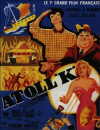|

 Laurel & Hardy inherit a yacht and an island and set out to sea
accompanied by a stateless refugee who offers to act as their cook in return
for a home on their island, and a stowaway. Their yacht founders in a
tropical storm, but providentially a newly created atoll emerges from
beneath the sea to save them. Settling down in their new home, they
are soon joined by a girl fleeing from her jealous fiancée. Together
they organize the island as their own private Republic, and all goes well
until uranium is discovered. Laurel & Hardy inherit a yacht and an island and set out to sea
accompanied by a stateless refugee who offers to act as their cook in return
for a home on their island, and a stowaway. Their yacht founders in a
tropical storm, but providentially a newly created atoll emerges from
beneath the sea to save them. Settling down in their new home, they
are soon joined by a girl fleeing from her jealous fiancée. Together
they organize the island as their own private Republic, and all goes well
until uranium is discovered.
The nations of the world battle over ownership
of the atoll, and money-hungry adventurers swarm there. The little
party is about to be lynched when another timely eruption sinks their atoll
beneath the waves once more. A passing ship rescues them.
Suzy is reunited with her now contrite fiancée,
but
Laurel & Hardy, finally reaching their own island, find that inheritance
and other taxes are so staggering that they must forget their dreams of a
life of ease.
Laurel and Hardy's final film was almost as much of a misfire as
Chaplin's A King in New York, but it was nevertheless a courageous
effort to do something different, and in this respect at least it was a far
more worthwhile venture than most of their later U.S. releases. But it
was one of those unfortunate productions foredoomed to failure by budget
limitations and problems of communication between a multilingual crew.
Much of its political satire needed wit rather than visual humor or, better
still, a delicate blending of both in the Preston Sturges manner.
John Berry, a good directory of taut melodramas,
was clearly a totally unsuitable choice as the film's co-director, and
commercially a suicidal one for any film with a political tinge (even a
comic one), since he was then under a cloud in the United States as one of
the "unfriendly" Communists. The film received but scant U.S.
distribution in 1955, three years after its production, and no major
distributor would touch it because of its difficult marketability and the
problem of Berry's association with it.
  When it was finally released, it was cut by more
than two reels, and curiously some of the funniest sight-gag sequences were
among those deleted. Further hurting the film was the rather crude
dubbing for the non-Laurel
& Hardy roles, and most especially the appalling physical appearance of
Stan Laurel
himself. He had been extremely ill prior to and during production, and
looked far older and sicker in this film than he did more than ten years
later, just before his death. The shock of his appearance was such
that his admirers didn't feel like laughing at him, and by the time this
initial impact had worn off, it was too late to really warm up to the film.
Nevertheless, it had a certain charm and was quite undeserving of the total
obscurity into which it was hurled. When it was finally released, it was cut by more
than two reels, and curiously some of the funniest sight-gag sequences were
among those deleted. Further hurting the film was the rather crude
dubbing for the non-Laurel
& Hardy roles, and most especially the appalling physical appearance of
Stan Laurel
himself. He had been extremely ill prior to and during production, and
looked far older and sicker in this film than he did more than ten years
later, just before his death. The shock of his appearance was such
that his admirers didn't feel like laughing at him, and by the time this
initial impact had worn off, it was too late to really warm up to the film.
Nevertheless, it had a certain charm and was quite undeserving of the total
obscurity into which it was hurled.
Lacking in much of the standard
Laurel & Hardy humor (wisely, for they looked to old for their familiar
knockabouts to be appealing or even to have any point), it substituted
elements of whimsy and satire, and had much of the spirit of one of
Douglas Fairbanks' last films, the breezy Mr. Robinson Crusoe.
There was an abundance of sight gags, but most of them were bizarre gags for
immediate reaction, more reminiscent of
Buster Keaton than the carefully built routines of
Laurel & Hardy. Typical gags: Laurel leaning out of the
porthole during the hurricane to literally "pour oil on the troubled waters"
(the mountainous waves instantaneously subside!); Laurel burping his pet
lobster; and a wild episode in which a bat invades their cabin at night.
Laurel chases it, gradually maneuvering it to the window. But when he
opens the window, instead of the ne bat flying out, a whole swarm of
his comrades fly in!. The dialogue, too, was often quite
pointed and amusing, as in a good episode where Hardy allots the prime
political posts of his new Republic, giving key positions to himself, Suzy
Delair (a vivacious French actress, strangely lusterless here), and his
other two cohorts. All of the governmental posts have been filled
before Hardy gets to Stan, who is heartbroken that he has been ignored.
But Hardy pacifies him with a magnificently diplomatic line: "Why Stanley,
you're The People!"
Despite their age and the uncertainty of their
surroundings,
Laurel & Hardy keep the film going at a good clip. It falters only
in the lengthy and tedious cutaway sequence to establish the boy-girl
subplot, and in the climactic episodes when the commentary on political
wrangling and the tyranny of mob rule is inevitably too heavy for the comedy
balance to be maintained. However, the film brightens up again for its
finale with an unexpected "black" joke. The stateless refugee, once
more back to his old trade of trying to smuggle himself aboard outgoing
ships, hides this time in a lion's cage. All that is left as the cage
is swung aboard ship are his boots!
Atoll K was the last film in which
Laurel & Hardy appeared together. Stan had made no appearance at
all without Hardy since their initial teaming. Hardy worked in only
three films without Stan: Hal Roach's Zenobia 1939; a serio-comic
role in a 1949
John Wayne western, The Fighting Kentuckian; and a character
comedy vignette in Frank Capra's
Riding High in 1950. |
